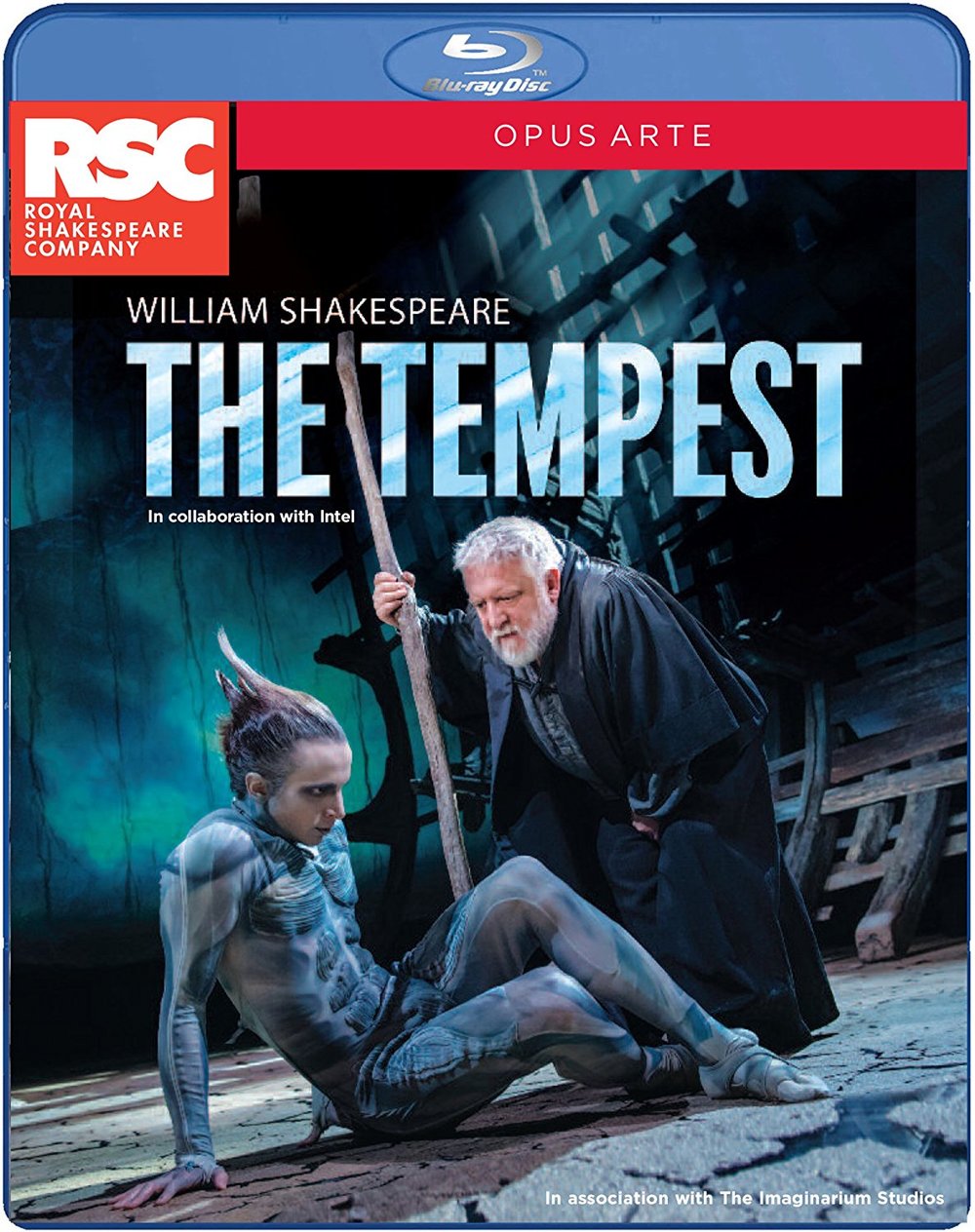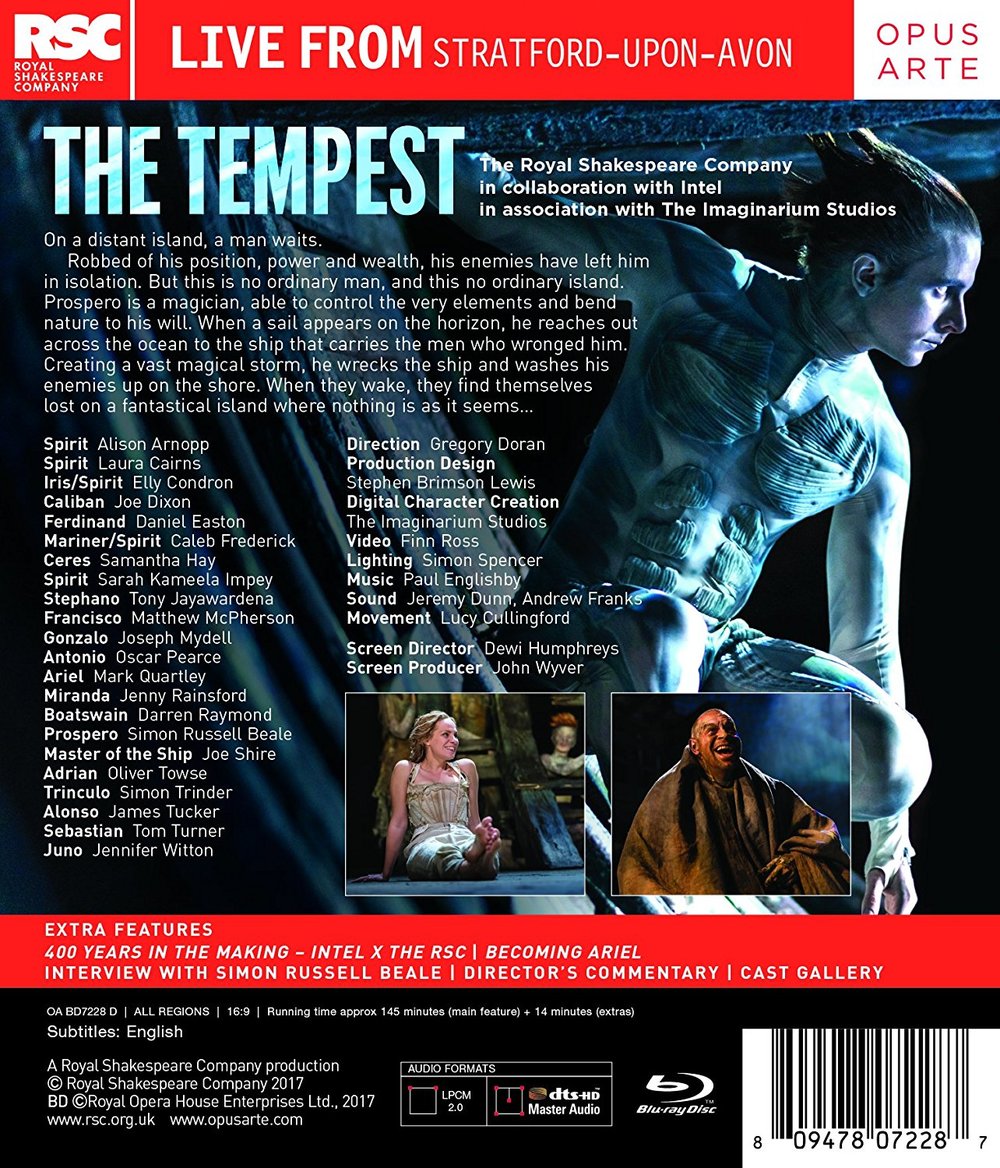

Shakespeare The Tempest play. Directed 2017 by Gregory Doran at the Royal Shakespeare Company Theatre. Stars (alphabetical order) Alison Arnopp (Spirit), Simon Russell Beale (Prospero), Laura Cairns (Spirit), Elly Condron (Iris/Spirit), Joe Dixon (Caliban), Daniel Easton (Ferdinand), Caleb Frederick (Mariner/Spirit), Samantha Hay (Ceres), Sarah Kameela Impey (Spirit), Tony Jayawardena (Stephano), Matthew McPherson (Francisco), Joseph Mydell (Gonzalo), Oscar Pearce (Antonio), Mark Quartley (Ariel), Jenny Rainsford (Miranda), Darren Raymond (Boatswain), Joe Shire (Master of the Ship), Oliver Towse (Adrian), Simon Trinder (Trinculo), James Tucker (Alonso), Tom Turner (Sebastian), and Jennifer Witton (Juno). Also features musicians Samantha Hay and Jennifer Witton (sopranos), Max Gittings (flutes/whistles), Nick Lee (guitar), James Jones (percussion), and Bruce O'Neil and Gareth Ellis (keyboards). Production design by Stephen Brimson Lewis; digital character creation by The Imaginarium Studios; video by Finn Ross; lighting by Simon Spencer; music by Paul Englishby; sound by Jeremy Dunn and Andrew Franks; movement by Lucy Cullingford. Directed for TV by Dewi Humphreys; screen production by John Wyver. Released 2017, disc has 5.1 dts-HD Master Audio sound. Grade: A+
This is a huge and elaborate production coming to us from the best resource for Shakespeare plays that has existed since the death of the Bard. On the whole it is quite excellent. The performances are engaging, the play is funny and affecting in equal measure, and the disc itself presents high quality audio and visuals. Of course the biggest talking point will be the elaborate use of visual projection and lighting to really make this production stand out. This includes not just projections on backdrops of different sizes and shapes, but also a real-time motion capture projection of Ariel. As the actor Mark Quartley moves around the stage, his suit sends information to computers behind the scene that then create the animated avatar (using 27 separate projectors). So when Mark moves, the spirit apparition moves along with him. This technology took two years to perfect, and the final product reflects the care taken by all involved. As elaborate as the visual side of this production is, at its core this is still a stage play done with the care that one would expect from the Royal Shakespeare Company; the visuals add extra verve without distracting from the play or the performance.
The stage itself is static—there are no changes in scenery. Instead the production relies on various lighting cues and projections to clue the audience as to changes in setting. The stage is a flat area painted to look like dirt, flanked on both sides by wooden scaffolding that doubles at various points as the wrecked ship, the walls of Prospero and Miranda's dwelling, and wooded areas. The scaffolding also provides additional levels for side actors to perform.
Here below we see the royalty on the main stage and the boatmen on the upper levels:
Prospero explains to Miranda how they arrived on the island. Here we see the basic scenery—dirt and wood, with no elaborate lighting trickery:
Prospero speaks to Ariel, here presented as a dancing spirit projected on the backdrop. This uses the live motion capture technology developed for this performance. (NB: The screenshots here are darker than the picture as it appears in the home theater. While the show is dark, it is not distractingly so. In fact, the visual effects shine all the more given the dark nature of the video.)
A more elaborate meshing of lighting and projection, representing Ariel's unfortunate time stuck in a tree. Here Mark Quartley plays Ariel twice, once physically in his suit, and again as the motion capture avatar projected on the center screen:
During calmer scenes, the lighting and projections take a break to allow the actors more attention, as shown below:
Stephano comes across the Caliban/Trinculo hybrid beast:
The visual effects are ramped up when Ariel descends as a harpy on Alonso, Antonio, and Sebastian. Here again we see two versions of Ariel—the actor on the second level and the spirit projected on the backdrop:
In one of the more elaborate scenes of the production, Prospero, Miranda and Ferdinand watch a colorful mini-opera (with music written for this performance).
The lighting is subdued during scenes of great emotion. Below, Prospero reacts to Ariel's compassion for the hexed men. (Ariel: Your charm so strongly works 'em / That if you now beheld them, your affections / Would become tender. Prospero: Dost thou think so, spirit? Ariel: Mine would, sir, were I human.)
A clever use of projection to represent Prospero's magic:
Lighting is used to great effect throughout the production—here characters are simultaneously cast in shadow and illuminated:
For the final soliloquy, all extraneous information is removed. We have solely the actor and the Bard's words (Prospero: . . .And my ending is despair / Unless I be relieved by prayer, / Which pierces so that it assaults / Mercy itself and frees all faults. / As you from crimes would pardon'd be, / Let your indulgence set me free.):
This is the second HDVD of The Tempest avialable. The first was the Taymor motion picture released in 2011 with Helen Mirren as Prospera (female version of Prospero). While both are excellent, the RSC version is the more traditional experience, regardless of the fancy visual effects used. If one values the aesthetic of the stage highly, then this would be The Tempest to buy.
Here are three clips about this production:
OR













